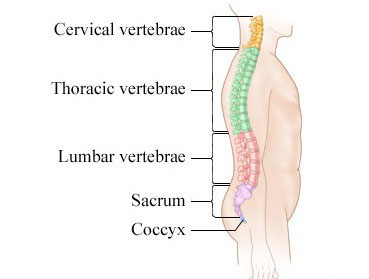Degenerative Disc Disease
What is Degenerative Disc Disease?
Degenerative disc disease is not really a disease but a term used to describe the normal changes in your spinal discs as you age. Spinal discs are soft, compressible discs that separate the interlocking bones (vertebrae) that make up the spine. The discs act as shock absorbers for the spine, allowing it to bend, flex, and twist. Degenerative disc disease, a common spinal condition, can take place throughout the spine, but it most often occurs in the discs in the lower back (lumbar region) and the neck (cervical region).
 The spine (backbone) is composed of 33 interlocking bones called vertebrae that are separated by soft, compressible discs and supported by many different ligaments and muscles. It is divided into five segments: cervical (neck), thoracic (upper and middle back), lumbar (lower back), sacrum (pelvis), and coccyx (tailbone). In each segment, the vertebrae are numbered from top to bottom. For example, a C4 is the fourth vertebra in the neck area, while a T5 is the fifth vertebra in the thoracic area.The vertebrae in the spine normally form 3 curves. These curves allow the spine to absorb shock as you move.
The spine (backbone) is composed of 33 interlocking bones called vertebrae that are separated by soft, compressible discs and supported by many different ligaments and muscles. It is divided into five segments: cervical (neck), thoracic (upper and middle back), lumbar (lower back), sacrum (pelvis), and coccyx (tailbone). In each segment, the vertebrae are numbered from top to bottom. For example, a C4 is the fourth vertebra in the neck area, while a T5 is the fifth vertebra in the thoracic area.The vertebrae in the spine normally form 3 curves. These curves allow the spine to absorb shock as you move.
What causes degenerative disc disease?
As we age, our spinal discs break down, or degenerate, which may result in degenerative disc disease in some people. These age-related changes include:
- The loss of fluid in your discs. Loss of fluid makes the discs thinner and narrows the distance between the vertebrae. This reduces the ability of the discs to act as shock absorbers and makes them less flexible.
- Tiny tears or cracks in the outer layer (annulus or capsule) of the disc. The jellylike material inside the disc (nucleus) may be forced out through the tears or cracks in the capsule, which causes the disc to bulge, break open (rupture), or break into fragments.
These changes are more likely to occur in people who smoke cigarettes and those who do heavy physical work (such as repeated heavy lifting). People who are obese are also more likely to have symptoms of degenerative disc disease.A sudden injury leading to a herniated disc may also begin the degeneration process.
The changes in the discs can result in neck or back pain and/or:
- Osteoarthritis, the breakdown of the tissue (cartilage) that protects and cushions joints.
- Herniated disc, an abnormal bulge or breaking open of a spinal disc.
- Spinal stenosis, the narrowing of the spinal canal, the open space in the spine that holds the spinal cord.
As the space between the vertebrae gets smaller, there is less padding between them, and the spine becomes less stable. The body reacts to this by constructing bony growths called bone spurs (osteophytes). Bone spurs can put pressure on the spinal nerve roots or spinal cord, resulting in pain and affecting nerve function.
What are the symptoms?
Degenerative disc disease may result in neck or back pain, but this varies from person to person. Many people have no pain, while others with the same amount of disc damage have severe pain that limits their activities. Where the pain occurs depends on the location of the affected disc. An affected disc in the neck area may result in neck or arm pain, while an affected disc in the lower back may result in pain in the back, buttock, or leg. The pain often gets worse with movements such as bending over, reaching up, or twisting.
Spondylosis is a term referring to degenerative osteoarthritis of the joints between the center of the spinal vertebrae and/or neural foramina. If this condition occurs in the zygapophysial joints, it can be considered facet syndrome. If severe, it may cause pressure on nerve roots with subsequent sensory and/or motor disturbances, such as pain, paresthesia, or muscle weakness in the limbs.
When the space between two adjacent vertebrae narrows, compression of a nerve root emerging from the spinal cord may result in radiculopathy (sensory and motor disturbances, such as severe pain in the neck, shoulder, arm, back, and/or leg, accompanied by muscle weakness). Less commonly, direct pressure on the spinal cord (typically in the cervical spine) may result in myelopathy, characterized by global weakness, gait dysfunction, loss of balance, and loss of bowel and/or bladder control. This may cause a phenomenon of shocks (paresthesia) in the hands and legs because of nerve compression and lack of blood flow. If vertebrae of the neck are involved it is labelled cervical spondylosis. Lower back spondylosis is labeled lumbar spondylosis.
